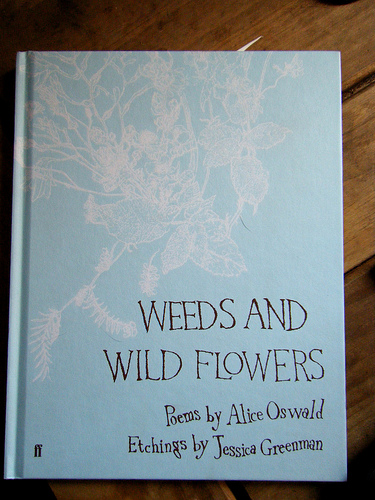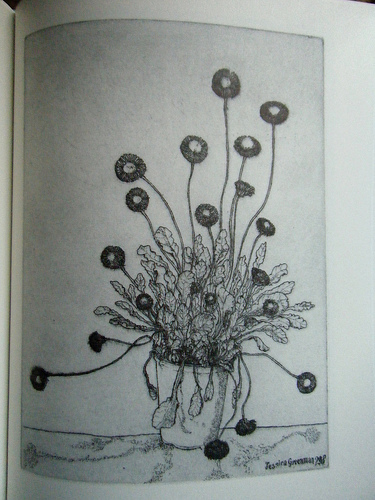Here begins what we hope will become a regular feature, a poetry review column by Katherine Venn. Katherine is the author of a great blog, the now complete, ‘Fifty-Two Poets‘, which is both a diary and a celebration of ‘a year of reading poetry’. I have to confess that in my list of ‘things to discover’ poets and poetry have rarely featured close to the top but reading ‘Dart’ by Alice Oswald has had a definite effect on me and left me open to suggestion. Shortly after reading ‘Dart’ I came upon ‘Fifty-Two Poets’ and asked Katherine if she’d be my guide. In this, her first column written especially for CBTR, Katherine reviews two recently released books by, appropriately enough, Alice Oswald:

(photos taken from flickr)
Earlier this year Faber published two new collections of poetry by Alice Oswald: A Sleepwalk on the Severn and Weeds and Wild Flowers, which includes etchings by Jessica Greenman. I thought it was interesting that each book opened by making a point of saying what it was not. A Sleepwalk on the Severn: ‘This is not a play’; Weeds and Wild Flowers: ‘not an illustrated book‘. (The latter was undercut by Faber’s own description of the book on its website, but then I work in publishing myself, so I wasn’t surprised.)
Fans of Oswald’s second collection, the T.S. Eliot-prizewinning Dart, will enjoy A Sleepwalk on the Severn, which finds the poet returning to water and, like Dart, creating a poem out of the various different voices connected with the Severn estuary (memorably described with pinpoint accuracy as ‘both a barren mudsite and a speeded up garden‘), specifically at moonrise. Each scene – new moon, half moon, and so on (though this is not a play, remember) – opens with two sleepwalkers: the moon, and the poet (the ‘dream secretary’), and then gives way to the voices of such characters as a birdwatcher, a fisherman, a sailor, a vicar… and of course the wind, the moon itself, and eventually ‘crowds lining the banks’:
It’s incredible when she visits her rivers,
Dragging her wave like a ghost-robe
Right across the sea and earth and through everything…
… It’s incredible when she chooses to push
The river right over without caring,
And there’s the earth dangling in emptiness
With its feet kicking the air, it’s incredible
When she floats along in her havoc not breathless at all
It’s a beautiful piece of writing, at turns comic, wistful, creepy, poignant. As well as being similar to Dart, of course, it also reminded me of the very funny ‘The Three Wise Men of Gotham who Set Out to Catch the Moon in a Net’, in Oswald’s first collection, The Thing in the Gap-Stone Stile. And what I really love about Alice Oswald is here in buckets: a startling newness of vision that demands that you pay attention. In fact in Sleepwalk this is made explicit: in the prologue the reader is commanded to ‘Listen‘, while the poet herself says ‘I notice‘, and later on ‘notice everything noticing‘. This calling to attention is repeated throughout the poem: the request is always to pay attention, to listen, to take notice of the minutiae of all the
… many moodswung creatures
That have settled in this beautiful
Uncountry of an Estuary
I think it’s this keenness of vision, without romanticism, that has seen Oswald called a successor to Ted Hughes. It’s also in the way she writes: using language in new and unexpected ways (‘moodswung’; ‘uncountry‘) is part of the way she startles you out of inattention. Everything is new: everything calls for notice to be paid.
There’s a whimsical tone that runs through the poem, a sort of shifting to and fro, like the water and the moon, supported by (in many of the scenes, many of the voices) a general lack of punctuation. And the references to flute music, children singing and a chorus, plus the comic openings to each moonrise, reminded me somehow of some of Shakespeare’s comic scenes – the ones set at night, where everyone’s confused and falling over, and everything magically turns into something, or someone, else. The ‘dream secretary’ has the last word, back home, standing in her own garden, glancing up at the moon:
Sometimes the moon is more an upstairs window,
Curtains not quite drawn but lit within and lived in.
And sometimes the moon is less and
Sometimes she moves behind and sometimes she’s gone.
Sometimes it’s the moon. Sometimes it’s the rain.
So, Weeds And Wild Flowers, which is also not something that it looks like (ie an illustrated book). Actually I think it’s an important and valid distinction: the artist, Jessica Greenman, hasn’t taken each of the poems and illustrated them; rather it’s a book of etchings and poems that have been ‘shuffled together’. It’s a book that’s slightly hard to describe without it sounding hopelessly twee, so it’s probably best to let the poet describe it herself: her contention is that ‘flowers are recognisably ourselves elsewhere‘, and so she uses ‘the names of flowers to summon up the flora of the psyche’. And so we have the dirty old man of ‘Stinking Goose-foot’; the gin-soaked ‘Hairy Bittercress’; and the ‘pale and pining girl’ of ‘Snowdrop’. The often extraordinary names of the plants and flowers that Oswald writes about are enough to convince you of the premise for the book, I think. Meet ‘Bastard Toadflax’:
Ponderous, obstinate,
cold-skinned person.
Very swollen eyes.
Gets fidgets often.
Makes passes
at unsuspecting lasses.
Tips chair, untips chair.
Tips. Untips.
Sits in damp places
flattering and heckling.
It’s a real treat of a book, physically speaking; unlike the rather flimsy A Sleepwalk on the Severn, which isn’t produced quite to Faber’s usual standards, Weeds is a lovely large-format hardback, crown quarto size, printed on beautiful thick creamy art paper. Lovely. The size makes it reminiscent of children’s picture books, which is appropriate I think; it’s like a rather dark version of a child’s book of flowers – Struwwelpeter meets the Flower Fairies, with a bit of Ted Hughes thrown in for some sticky, visceral darkness. It’s the darkness that saves it from being at all fey, which it isn’t, though a book of poems and etchings about human qualities in flowers sounds like it should be. It’s definitely the kind of book I’d find impossibly contrived in someone else’s hands, but Oswald has a touch that makes it work. That said, it does seem to tip over in a couple of places; I found the artist’s writing on her etchings rather affected, and I didn’t think it was really necessary to have a straight engraving of the poem ‘Narcissus’.
Many of the poems get their energy from the peculiar and suggestive names of the plants, like those mentioned above, or ‘Bargeman’s Cabbage’ and ‘Mother of Thousands’, which quite naturally conjure up their own literal and often grotesque associations. But it’s the poems that are more oblique, like ‘Violet’ and ‘Primrose’, which have a more delicate, but still rather frightening, feel, that I really enjoyed. ‘Violet’ is ‘Recently fallen, still with wings out,/she spoke her name to summon us‘ and submits to being picked, her audience ‘fingering her blue bruised skin’. ‘Primrose’ starts out like a classic pastoral: ‘First of April – new born gentle./Fleeting wakeful on a greenleaf cradle‘, but quickly fades and then accelerates into
Face like wet paper. Hanging yellow head.
Still there. Still dying. Fourteenth of April.
Face fading out. Expression dreadful.
Fifteenth sixteenth. So on so on.
Until she’s simply ‘Skull in the grass. Very light and crumbly.’
As with Sleepwalk, Weeds and Wild Flowers encourages the reader to look closely, to encounter each individual plant or flower. But here the looking takes on a darker, more sinister tone. ‘Daisy’ has the poet refuse ‘to look in her open eye‘, instead making ‘a lovely necklace out of her green bones‘, while ‘Violet’, ‘let her purple deep eye-pupil be peered into’ but is ‘frightened’, ‘horrified’.
So if you like your poetry new, original, comic, arrestingly beautiful and slightly disturbing, both books are highly recommended. I’m already looking forward to what Alice Oswald writes next.
Weeds and Wild Flowers – poems by Alice Oswald, etchings by Jessica Greenman, Faber and Faber (March 2009)
A Sleepwalk on the Severn – Alice Oswald, Faber and Faber (April 2009)
